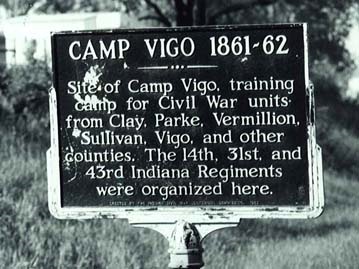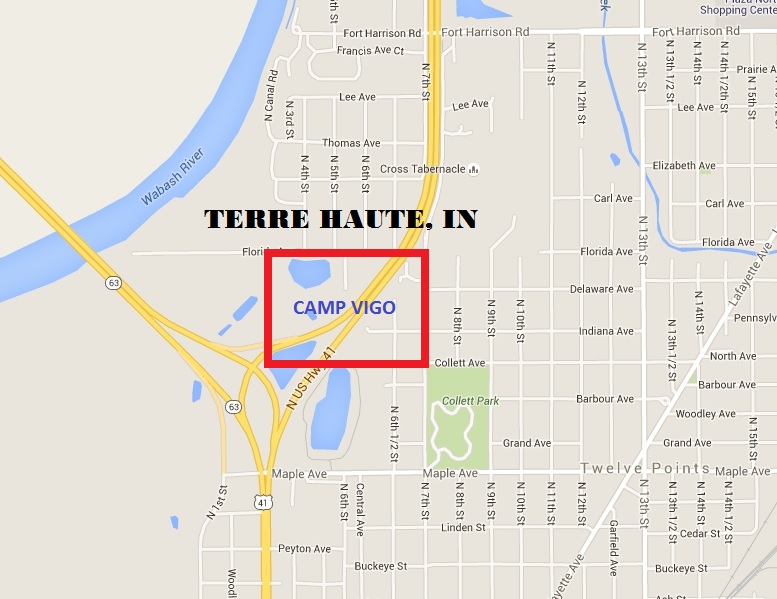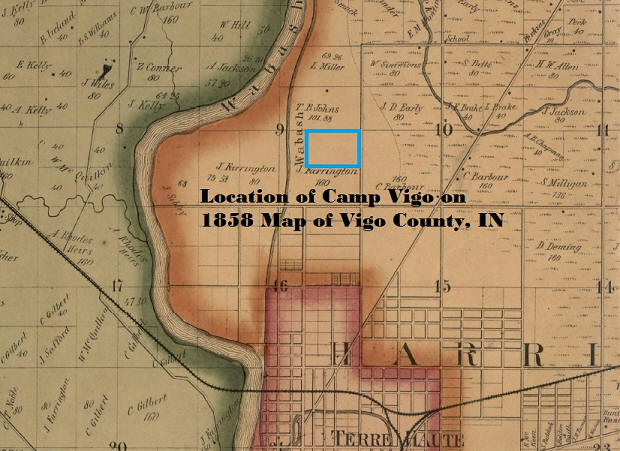|
Camp Vigo
During the Civil War,
mustering or rendezvous camps were used to gather Home Guards and volunteers
from the surrounding counties and
towns into companies to form regiments. Here the soldiers learned their first
lessons in soldiering, even though they may not have yet obtained uniforms or
arms. Many learned their left foot from their right, using hay and straw
stuck into their shoe laces or tied around the shoe to distinguish left (Hayfoot)
from their right (Strawfoot).
Very little has been written about Camp Vigo. It is mentioned
in letters, diaries
and memoirs by many of the soldiers who mustered in there, but its location and
features have not been well documented. During its short life as a
recruiting camp, three regiments were formed at Camp Vigo, the 14th,
31st and 43rd Indiana Volunteer Infantry regiments.
The Vigo County fairgrounds north of Terre Haute, IN were made into Camp Vigo
beginning around the 10th of May 1861.
The camp was named in honor of Francis Vigo, the famous Italian Revolutionary
War patriot and fur trader for whom
the County was named after. The land for the
fairgrounds was purchased by the Vigo County Fair Grounds Company in 1859 from Demas
Deming who was a trustee for the creditors of James Farrington the original
land owner.(1) The grounds covered approximately
51 acres and was located west of 7th street. To get an idea of where the fairgrounds
and camp was located, picture it being opposite
of the NW corner of present day Collett Park. This would have been the SE
corner of the fairgrounds. Essentially if one draws a rectangle starting
at the corner
of 7th and Collett Avenue, then draw a line directly west to where 3rd
street would intersect, then go north and stop at Florida Ave., then head east along Florida
Ave. to 7th Street, then turn south and follow 7th street back to Collett
Ave. Shortly after the Civil War the grounds were sold to John J. Brake on
June 28, 1865.(2) See map
at the bottom of this page.
The camp was enclosed by a high board fence. Along the sides were stalls
that were used during the county fair to house and display livestock and farm
equipment. There were some stalls that had overhead lofts where the new
recruits made their quarters. The soldiers lived and cooked their meals on
the first floor and slept upstairs in the straw.
The
book GALLANT FOURTEENTH (3), describes how the
former fairgrounds was used, "Its mechanical-arts and other fair buildings were
to be used as barracks and its display fields as parade grounds, but it could
not be readied for at least a week from the time of its designation by the
legislature. Men arriving for the new regiment [14th Indiana] had to be
housed at the firehouse in downtown Terre Haute."
The camp was used from around early May through October 1861 as a recruiting
camp. It is believed to have been turned into a prison camp called Camp
Harrison for a short time in 1862, however I have not found reliable
documentation to confirm this. It is known that several Confederates were
sent to Terre Haute after the battle of Fort Donelson. Some are buried in
Woodlawn Cemetery.
Daily Camp Life:
"Soldiering" as one would expect was very new and different to a bunch of young
farm boys or boys from town. Camp life was exciting and at first, somewhat
scary, but a daily routine soon changed them. Those first few days in camp
would be something they would talk about for the rest of their lives with
fondness. Fun and "hilarity" was common and many times tricks, jokes and pranks
would occur requiring discipline to be administered. Some were locked up
in the "Guard House" for their offenses including the charge of "drunkenness".
The
following excerpt from the Memoir by William Turner Glenn of Company "G", 31st
Indiana Volunteer Infantry(4), gives one a good
idea of what camp life was like for a new regiment.
"Camp life, as experienced by
the boys of Co. G, is now described. First thing in the early morning was
the reveille call, performed by fife and drum. This signalized the
beginning of the day. The sleepy and the snoring were rudely awakened,
told to pick the straw from their hair, carefully fold blankets and don
uniforms.
Those who had been delegated
to prepare breakfast, eagerly set to work at the various chores assigned.
Other men, while breakfast was being prepared, went through a series of
exercises, as prescribed by Army regulations.
When the morning repast was
announced, the men, with great celerity, flocked to the tables with fare
from pots, pans a skillets. The day’s work was thus fairly inaugurated.
After breakfast, came Police
Call, at which time all litter and rubbish on the grounds were gathered
and disposed of beyond camp confines.
At seven o'clock was the
Surgeon's call. The sick and lame went to the Surgeon's quarters for
examination and treatment. Should any in camp resort to feigned illness or
indisposition, an unpalatable potion was dispensed to speed up recovery.
Results were effective in this respect.
Another performance of fife
and drum filled the air at seven-thirty. This indicated the time had come
for drill, all Companies participating. Drilling for some time, the men
were ordered to their respective quarters for a period of rest. After a
brief rest, drilling was resumed. Co. G was rated as one of the best
drilled outfits in camp.
Promptly at noon, was the
dinner call, the most welcome call of all. Drilling began again in the
afternoon..
At six o'clock, assembly call
spread its summons over the camp. Every Company of the Regiment fell into
groups and lined up in front of Headquarters. From here, they marched to
the parade grounds, where the entire Regiment was to be reviewed by the
Adjutant.
The band played a march and
then a quickstep while the Companies were forming in line. The Adjutant
turned the Regiment over to the Colonel, who put his troops through all
the different evolutions given in the Manual of Arms. The Adjutant
afterwards took charge, commanding all the Orderly Sergeants to report the
condition of their Companies.
Then the Commissioned Officers
proceeded to the front and center of the Regiment and lined up facing the
Colonel, who was saluted. The Colonel then paid compliments or offered
criticism, according to his views. The various Companies returned to their
quarters, this march being in charge of orderlies.
At nine o'clock was tattoo by
the drummers. This was time for roll call. When taps sounded, lights were
extinguished and bedtime had arrived. For the day, camp duties were over.
So, day by day, Co. G was fast developing into a fighting force, which
later was to do battle with the enemy."
At the entrance a guard was posted. Each person
entering was asked by the guard, "Soldier or Citizen?" As a new
recruit, you would answer "Citizen". As you entered you would pass a Sutler
(civilian merchant) stand. Normally a Captain would administer you an oath,
however this would not be the final oath you would take before officially
becoming a member of a regiment. You would then be shown where you
were to bunk and the recruit would be assigned to a mess of consisting of
4 to 6 men. The responsibility of cooking for the mess would fall on
you on certain days.(5)
From John Day's Memoir (6) comes
this excerpt referring to being assigned to a mess;
“This is where
we live, make yourself at home” said Sergt. Cox. I was assigned to a mess
(No. 4) and was told by the head of the Mess that according to rule it
would devolve on me to cook the next day, but I would have an assistant.
This was something I had never done and told him so. “You
will soon learn. Many of us never cooked a pot of pork in our lives until
we came into camp” he said “and now we can well enough for a General.”
I didn’t like the idea at all but as I was a new recruit, I said
nothing more.
"Next morning
I was shown the cooking utensils and “grub” to cook & furnished with a
list of the Mess and went [to] work. My assistant helped, of course, and
with his instructions I got along tolerably well. No one grumbled as I
feared they would. Dinner and supper were cooked and I went to my bunk to
rest rejoicing that the dreaded task was over for that day."
Historical Marker:
In 1962 the
Indiana Civil War Centennial Commission erected a Historical Marker ID#:
84.1962.1 on U.S. Hwy 41 about Camp Vigo It is no longer standing.
The text of the Marker is:
CAMP VIGO 1861-1862
Site of Camp Vigo. training camp for Civil War units from Clay, Parke,
Vermillion, Sullivan, Vigo and other counties. The 14th, 31st. and
43rd Indiana Regiments were organized here.
NEW HISTORICAL MARKER:
I would like to initiate installing a new
Historical Marker. I believe it should be placed at the NW
corner of Collett Park instead of on the highway as before. This
is no small task and I will need help from individuals and hopefully a
History Group from the area. If you are interested in supporting
this effort please contact me.
|
 |

Present day map above, 1858 Map below

Return to Top of page
Sources:
(1)
Article by Mike McCormick entitled VIGO COUNTY'S FIRST FAIR STAGED IN 1852
from the Terre Haute Tribune Star, October 2, 2004.
(2) Ditto
(3) GALLANT FOURTEENTH, The Story of an Indiana Civil
War Regiment by Nancy Niblack Baxter, 1980.
(4) from the booklet, COMPANY "G", MONROE COUNTY'S
CONTRIBUTION TO THE CIVIL WAR, written by Bennett P. Reed, containing the
Memoir by William Turner Glenn of Company "G", 31st Indiana Volunteer
Infantry, published by: Monroe County Historical Society, Bloomington,
IN.,
(5)
Memoirs of Private John Day, 31st Indiana, Co. K. (William Henry Smith
Memorial Library)
(6) Ditto

[ The Colonels ]
[Camp Calhoun & Ft. Donelson ] [ Shiloh ]
[ Murfreesboro ] [ Chickamauga ]
This site was written by:
Dennis Hutchinson
I am interested in anything connected with the
31st Indiana Vol. Infantry, or if you have any questions please feel
free to contact me by E-Mail.
I am especially interested in photos of
soldiers from the 31st Indiana in their wartime clothing. I am
also interested in any letters, diaries, or biographical information on
31st Indiana soldiers
Contact: 31st Indiana
Copyright © 1998 - 2021 by Dennis Hutchinson. All Rights Reserved.
This site may be freely linked to, but not duplicated in any fashion
except by the author's consent. When permission is given, this copyright
statement must remain with the document.
Last Update May, 2021
Return to the
31st Indiana
Home Page

|